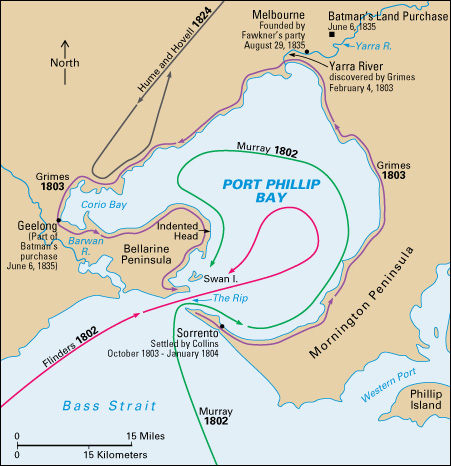Port Phillip Bay is a large inlet of Bass Strait, on the southern coast of Victoria, Australia. It has an area of 10 square miles (27 square kilometers) and a shoreline of 140 miles (225 kilometers). It extends northward for 37 miles (60 kilometers) from its entrance, the fast-flowing Rip, a narrow passage between Port Lonsdale in the west and Point Nepean in the east. Melbourne is at the head of Port Phillip Bay, and Geelong is in the west.

Port Phillip Bay was first entered by Lieutenant John Murray on Feb. 15, 1802. The British navigator Matthew Flinders came to the bay later that year. Surveyor General Charles Grimes, who arrived on Jan. 20, 1803, examined the land surrounding the bay. In October 1803, Lieutenant Colonel David Collins tried to establish a penal settlement near Sorrento, but he soon abandoned it. Two of the convicts escaped. One of them, David Gibson, traveled in the area before returning to Collins. The other, William Buckley, traveled right around the bay. Buckley lived with Aboriginal people west of Geelong for 32 years.
On May 29, 1835, the livestock farmer John Batman arrived and explored the area. He concluded a treaty with local Aboriginal inhabitants at Merri Creek, near Northcote, now a suburb of Melbourne. Batman obtained 600,000 acres (243,000 hectares) of land, including the sites of Melbourne and Geelong. He left three Europeans and five Aboriginal people from New South Wales to establish a garden at Indented Head, on the Bellarine Peninsula.
The Enterprise, owned by the pioneer John Fawkner, who was not aboard, reached Port Phillip Bay and entered the Yarra River on Aug. 29, 1835. This ship left five European men and women behind to build a wharf and shelters. The five first settled near the present location of Spencer Street Railway Station, then known as Batman’s Hill. They moved to the south bank when Batman’s brother, Henry, arrived. Batman built a weatherboard house on the hill. Fawkner arrived on Oct. 10, 1835, and built a house on the north bank. John Batman returned in November.
Land-hungry colonists from Van Diemen’s Land (now Tasmania) soon followed. Three years after Batman’s treaty, the population had grown to 3,511 white settlers. The settlers had 311,000 sheep and 13,372 cattle. Australia’s fastest-growing center, Melbourne, was proclaimed a town in 1842 and a city in 1847. First known as Port Phillip, the settlement was declared a separate colony, Victoria, in 1851.
